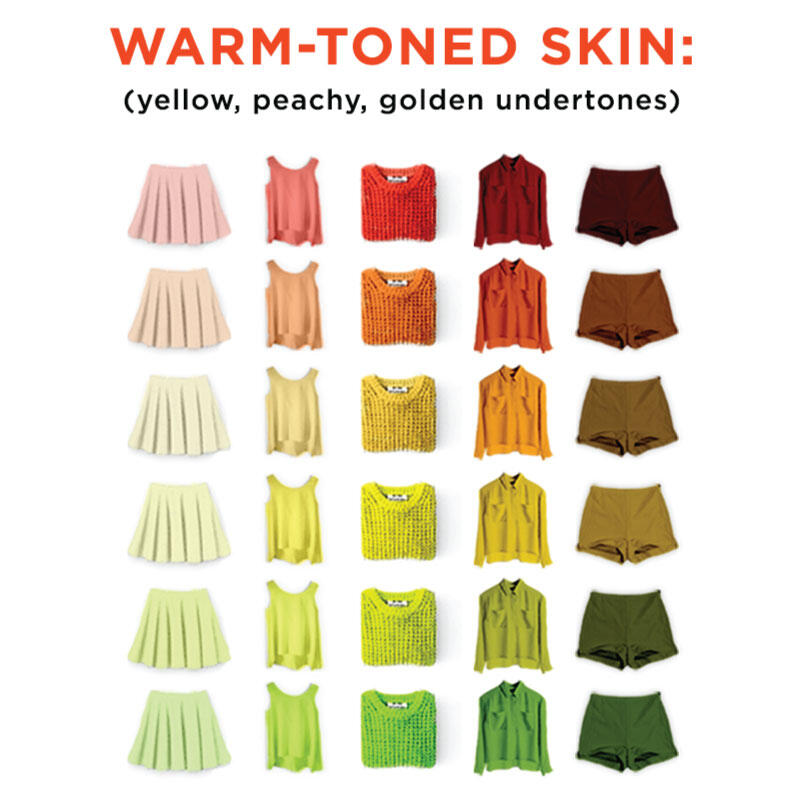 l
l
So how can I determine my skin’s undertone?
Well, there are actually several ways you can do this. And I’ll explain each one now for you.
You can either choose one of them. But I actually recommend taking a look at all of them. As that will give you a much more accurate result.
Firstly, grab a pen and a piece of paper. And as you’re asking yourself the following questions, write down your answer to each one. Which will be A, B or C.
Once you’ve finished, add up your scores (i.e., how many A’s, how many B’s, etc.). And at the bottom of this post, you’ll be able to determine what your skin’s undertone is. So let’s get started.
1. How does your skin react to the sun?
This is a great indicator of whether your skin has a warm, cool, or neutral undertone. So ask yourself. Do you burn easily in the sun? Or do you tan easily? Perhaps you’re a mixture of both?
Question: In the sun, I:
A. Tan easily
B. Burn easily
C. Tan slightly
2. What colour of jewellery looks best on you?
You can also do this with something else that’s gold or silver. For example, with gold and silver scarves.
Hold both shades up to your face. And whichever one brightens and enhances your complexion best is the shade that will determine whether your undertone is warm, cool, or neutral.
Question: I look better wearing:
A. Gold Jewellery
B. Silver Jewellery
C. Both
3. What neutral colours suit you best?
This is a really simple way to determine what your skin’s undertone is.
Do you look better wearing black or white? Or do you look better when you wear brown or cream? Or perhaps you look good in both?
Question: I look better in:
A. Cream or Brown
B. White or Black
C. I look fab in both
4. What colour are your veins?
This one can be one of the most difficult for people to determine, as it’s not always so easy to see. In fact, this is one I had a bit of trouble with when determining my own undertone. But it’s worth doing it anyway.
Take a look at the veins on your wrist. Do they look green or blue, or are you not sure?
Question: My Veins are:
A. Green
B. Blue
C. I can’t tell
5. Look at your skin
Now it’s time to take a good look at your skin itself. Go somewhere where there’s natural light, and take a mirror with you. For example, in front of a window. Or even go outside if you have to.
Just make sure you’re not somewhere that’s very dark or has unnatural lighting, such as fluorescent lighting in a bathroom. Otherwise, you won’t be able to properly see what your true skin undertone is.
Question: When I look in the mirror, my skin undertones look:
A. Yellow, peach, golden
B. Pink, blue, rose
C. Both, I think
Be mindful of this common misconception
You might be thinking that if you have a light skin tone, it means you have a cool undertone. Or that if you have a tan or dark skin tone, you have a warm undertone. But that’s not necessarily the case.
For example, I have a light skin tone. But I have a warm undertone.
Likewise, someone with dark skin can have a cool undertone. And someone else with dark skin could have a warm undertone.
So you can see that skin tone really has nothing to do with skin undertone. And that’s why it’s important to know the difference between the two.
So let’s take a look now at why and how it can be so beneficial to you.
What’s the benefit of knowing my skin’s undertone?
Knowing your skin’s undertone is very helpful when choosing clothes and makeup.
The reason is that knowing your undertone is will help you choose colours and shades that will enhance your complexion.
For example, if you have a warm undertone to your skin, then choosing warm colours and shades that have warm undertones to them will enhance your complexion and give it a rejuvenated, refreshed, and brighter look.
Whereas if you choose colours that are too cool for your skin tone, they’re just going to make you look washed out, tired, and ill.
The same principle can be applied if you have a cool undertone. If you choose shades that have a warm undertone, they can look too orange on your complexion.
Using Your Skin Undertone to Choose Makeup Products
Let’s look at how you can use this when choosing makeup.
Lipstick
Once you know your skin undertone, you can use it to choose the best, most flattering lipstick shades for your complexion.
Blusher
You can also use your skin undertone to choose the right blusher shade.
The ones that will take you from looking pretty to pretty amazing. And that will look so flattering on your complexion.
Foundation
Knowing your undertone can also really help you to find the right foundation that will enhance your complexion and give it a healthy, refreshed glow.
For example, if you have a warm undertone, choosing a foundation with a cool undertone can make you look pale and washed out.
Likewise, if you have a cool undertone and you choose a foundation with a warm undertone, it can look too orange on your skin.
Hair colour
You can also use your undertone to find the most flattering hair colour when you’re at the hair salon. Again, you can apply the same principle as with makeup.
So if you have a warm undertone, choose hair colours that are also quite rich and warm that will flatter and enhance your complexion. Think warm shades of blonde, brown, red, for example.
If you’re cool-toned, think of cooler shades such as ash blonde and brown shades.
Check Your Scores:
So, are you ready to find out what your skin undertone is? Great, then let’s have a look at your scores.
If you had mostly A’s: You’re warm toned
Did you have mostly B’s, if so: You’re cool-toned
Or perhaps you had mostly C’s, in that case: You’re neutral-toned
I really hope this post was helpful for you.



